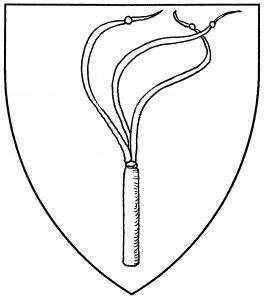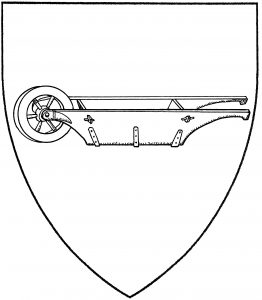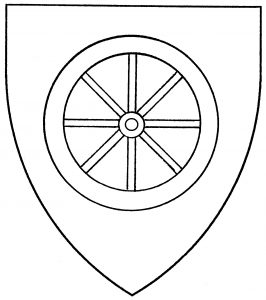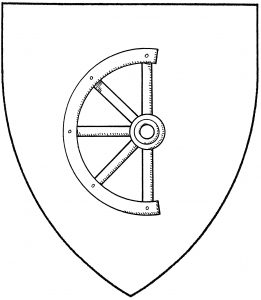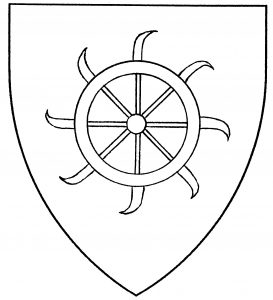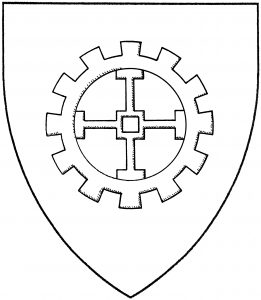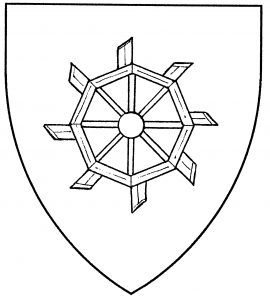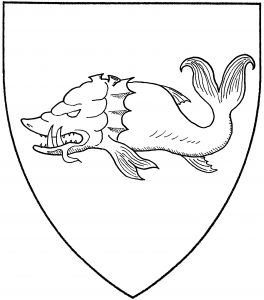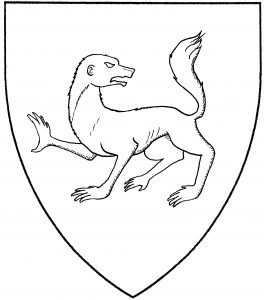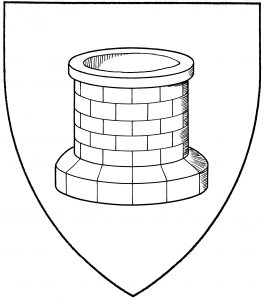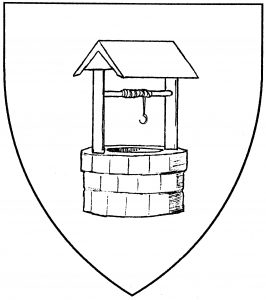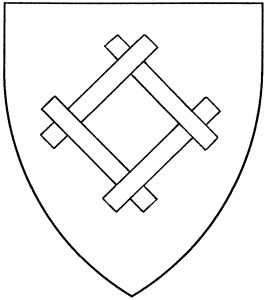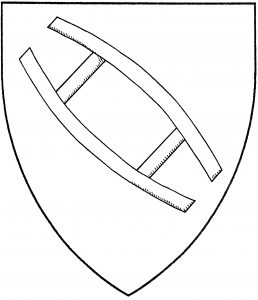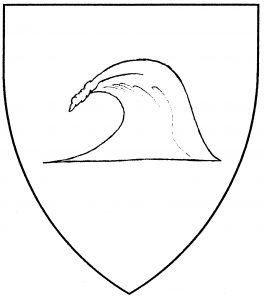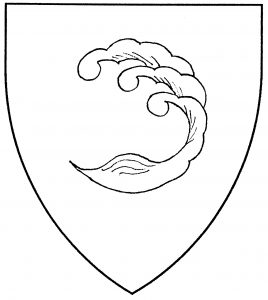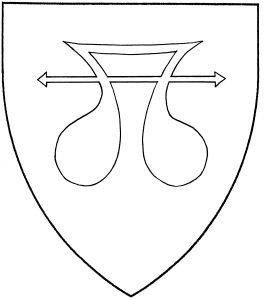Deadra Colin Madoc bears: Argent, a drover’s whip bendwise sinister, lash in action sable.
Valgard Stonecleaver bears as a badge: Or, a scourge sable.
Archives
Wheelbarrow
Hannes zum Eichhorn bears: Per fess vert and Or, a wheelbarrow and an acorn counterchanged.
Wheel
Particularly in German heraldry, we find examples of partial wheels: a quarter-wheel, as in the arms of von Billick, 1605 [Siebmacher 71], or a half-wheel, as in the arms of Rusetzker [Siebmacher 73]. The orientation of the partial wheel (e.g., “dexter half of a wheel”, as in the illustration) must be specified in blazon.
Variants of the wheel include the “Catherine’s wheel”, the symbol of the martyr St. Catherine, with curved knife-blades radiating from the rim. As an heraldic charge, it’s found in the arms of Brentingham, Bishop of Exeter 1370-94 [DBA3 443]. There is the “cog-wheel”, also called a “gear-wheel” or “mill-wheel”, with an embattled outer edge, used in mechanisms from tiny clockworks to giant mill-works; it’s found in the canting arms (German Mühle, “mill”) of Mülinen c.1460 [GATD 20v]. Finally, there is the “water-wheel”, unique to Society armory, with vanes on the outer edge to draw power from running water. See also grindstone, spinning wheel.Cyprian of the Wheel bears: Argent, a wooden cartwheel of twelve spokes proper.
Caterine Barré de Venoix bears: Barry azure and Or, a Catherine wheel gules.
Iathus of Scara bears: Ermine, a cog wheel gules.
Patrick MacFynn bears: Per chevron vert and azure, a chevron argent between two natural dolphins embowed respectant Or and a water wheel argent.
Catherine de la Loire bears: Purpure, a Catherine’s wheel missing the dexter chief quarter between three fleurs-de-lys argent.
Whale
The medieval depiction of the whale was somewhat fanciful; the illustration is taken from Gesner’s De Avibus et Piscibus, 1560. If a naturalistic depiction is desired, it must be specified as a “natural whale”, or more explicitly, e.g., a “sperm whale”. The whale is naiant by default.
In Society armory, there is also the “narwhal” or “narwhale”, a cetacean with a long unicorn-like “horn” (actually its tooth). It’s generally depicted as found in nature. The illustration shows a narwhal haurient. For related charges, see dolphin.
The Baron of Smoking Rocks bears: Argent, a whale haurient embowed sable within a laurel wreath vert.
André of Stormhold bears: Argent, a whale naiant azure.
Arinbjorn Talverri bears: Or, a narwhal haurient bendwise purpure.
Werewolf
The werewolf has no default posture; the illustration shows a werewolf passant reguardant.
Jeanne Marie Lacroix bears as a badge: A werewolf passant reguardant vert.
Oddr Þiálfason bears as a badge: A werewolf passant sustaining over its shoulder a pole with a gonfanon dependent therefrom Or.
Well
Some period arms depict wells (of all shapes) with a swape, or lever arm for drawing water.
In more modern heraldry, the well is depicted with a wooden cover or roof, and a cradle for a pail and rope [Franklyn 346]. This form of well was the first form registered in the Society; while still permitted, its use is now considered a step from period practice.
Neither form of well is the Society default. The type of well must be explicitly blazoned: either “open” or “roofless”, or “covered” or “roofed”.
There is also the “Japanese well-frame” or “well-curb” (igeta), with examples dating to the 15For related charges, see fountain.
Jon Blackwell bears: Argent, a covered well sable.
Alina Meraud Bryte bears: Per fess rayonny azure and argent, an open book argent and a roofless well gules.
Gwenllian Brighid Hertewelle bears: Vert, in pale a stag’s head cabossed Or and a roofless stone well argent.
Kameyama Kengōro bears as a badge: Argent, the kanji shu within a Japanese well-frame sable.
Weinleiter
Tamara Samuilova of Thamesreach bears as a badge: A weinleiter bendwise vert.
Hallr brjost Starsson bears as a badge: Per pale Or and quarterly gules and argent, a weinleiter bendwise sinister sable.
Weapons
Weapons are implements designed for combat or war; unlike armor, they are understood to be primarily offensive in nature. As medieval heraldry was originally borne by the warrior class, weapons were often used as charges.
For specific entries, see: arrow, axe, battering ram, bow, cannon, catapult, chaine shot, crossbow, fireball, flail, gun, hammer, knife, mace, pole-arm, pole-cannon, sling, spear, staff (club), streitgabelklinge, sword, trident, vajhra, zulfikar. See also quintain, quiver, scabbard.
Wave
The Occidental ocean wave may be stylized as one of the single elements of the wavy-crested line of partition; or it may be drawn naturalistically, with foam and spray. These stylizations are considered either “landscape heraldry” or intrusively modern, and are therefore disallowed.
In Japanese Mon, the nami or Great Wave employs a different stylization, as borne by Oguri [Hawley 75]; but it cannot be described using European blazonry terms. This brings it outside the Society’s domain; it is therefore disallowed.
The Society’s default for waves changed over the years; both dexter-facing and sinister-facing waves have been called the default. (Dexter-facing waves have been default more often, and both the illustrated waves face dexter.) The most recent Society practice has been to blazon the wave’s orientation explicitly. For related charges, see stream.
Genevieve du Puits bears: Azure, a wave reversed argent and in chief a sun sable, fimbriated argent.
Ryugen Morite bears: Sable, a Japanese dragon’s head issuant from a Great Wave reversed issuant from sinister increscentwise argent.
Water-bouget
Constance Grey bears: Azure, three water-bougets Or.
Elspeth of Seal Cove bears: Purpure, a water-bouget erminois.
Margaret de Mey bears: Gules, three water-bougets argent.
